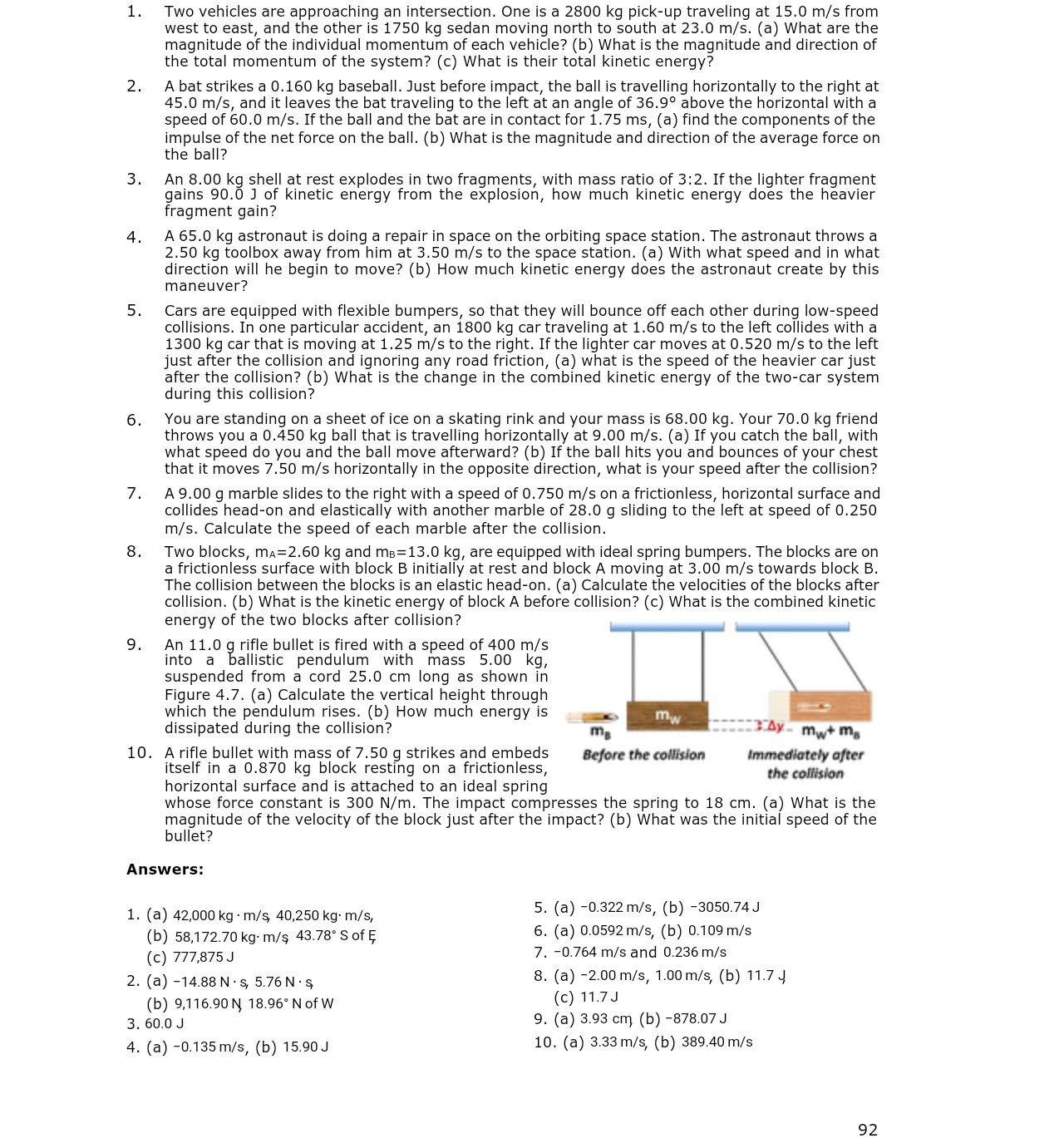10. Two vehicles are approaching an intersection. One is a 2800 kg pick-up traveling at 15.0 mfs from west to east, and the other is 1750 kg sedan moving north to south at 23.0 m/s. (a) What are the magnitude of the individual momentum of each vehicle? (b) What is the magnitude and direction of the total momentum of the system? (c) What is their total kinetic energy? A bat strikes a 0.160 kg baseball. Just before impact, the ball is travelling horizontally to the right at 45.0 m/s, and it leaves the bat traveling to the left at an angle of 369 above the horizontal with a speed of 60.0 m/s. If the ball and the bat are in contact for 1.75 ms, (a) find the components of the impulse of the net force on the ball. (b) What is the magnitude and direction ofthe average force on the ball? An 8.00 kg shell at rest explodes in two fragments, with mass ratio of 3:2. If the lighter fragment gains 90.0 J of kinetic energy from the explosion, how much kinetic energy does the heavier fragment gain? A 65.0 kg astronaut is doing a repair in space on the orbiting space station. The astronaut throws a 2.50 kg toolbox away from him at 3.50 m/s to the space station. (a) With what speed and in what direction will he begin to move? (b) How much kinetic energy does the astronaut create by this maneuver? Cars are equipped with flexible bumpers, so that they will bounce off each other during low-speed collisions. In one particular accident, an 1800 kg car traveling at 1.60 m/s to the left collides with a 1300 kg car that is moving at 1.25 m/s to the right. If the lighter car moves at 0.520 m/s to the left just after the collision and ignoring any road friction, (a) what is the speed of the heavier carjust after the collision? (b) What is the change in the combined kinetic energy of the two-car system during this collision? You are standing on a sheet of ice on a skating rink and your mass is 63.00 kg. Your 70.0 kg friend throws you a 0.450 kg ball that is travelling horizontally at 9.00 m/s. (a) If you catch the ball, with what speed do you and the ball move afterward? (b) If the ball hits you and bounces of your chest that it moves 7.50 m/s horizontally in the opposite direction, what is your speed after the collision? A 9.00 g marble slides to the right with a speed of 0.750 m/s on a frictionless, horizontal surface and collides head-on and elastically with another marble of 28.0 g sliding to the left at speed of 0.250 m/s. Calculate the speed of each marble after the collision. Two blocks, \"111:2.60 kg and m0=13.0 kg, are equipped with ideal spring bumpers. The blocks are on a frictionless surface with block B initially at rest and block A moving at 3.00 m/s towards block 8. The collision between the blocks is an elastic head-on. (a) Calculate the velocities of the blocks after collision. (b) What is the kinetic energy of block A before collision? (c) What is the combined kinetic energy of the two blocks after collision? An 11.0 rifle bullet is fired with a speed of 400 m/s into a allistic pendulum with mass 5.00 kg, suspended from a cord 25.0 cm long as shown in Figure 4.7. (a) Calculate the vertical height through which the pendulum rises. (b) How much energy is dissipated during the collision? A rifle bullet with mass of 7.50 g strikes and embeds itself in a 0.870 kg block resting on a frictionless, horizontal surface and is attached to an ideal spring whose force constant is 300 Mm. The impact compresses the spring to 18 cm. (a) What is the magnitude of the velocity of the block just after the impact? (b) What was the initial speed of the bullet? Answers: 1. (a) 42.000 kg-mxs, 40,250 kg- m/s, 5- (a) 'MZZWS: ('3) \"3050-7\" (b) 53,172.70 kg- m/s, 4373" s of 1; 6. (a) 0.0592 mls, (b) 0.109 mfs (c) 777375 J 7. -0.764 mls and 0.236 mts 2. (a) -14.33 N - s, 5.75 N - 3 8- (EU1'30 "ii/5.130 mfs,(b)11-7 4 (b) 9.110.901; 18.96\"NofW (C) 11-\" 3. 60.0 J 9. (a) 3.93 cm (b) -370.07 J 4. (a) -0.135 W3, (b) 15.90 J 10. (a) 3.33 m/s, (0) 339.40 m/s 92







